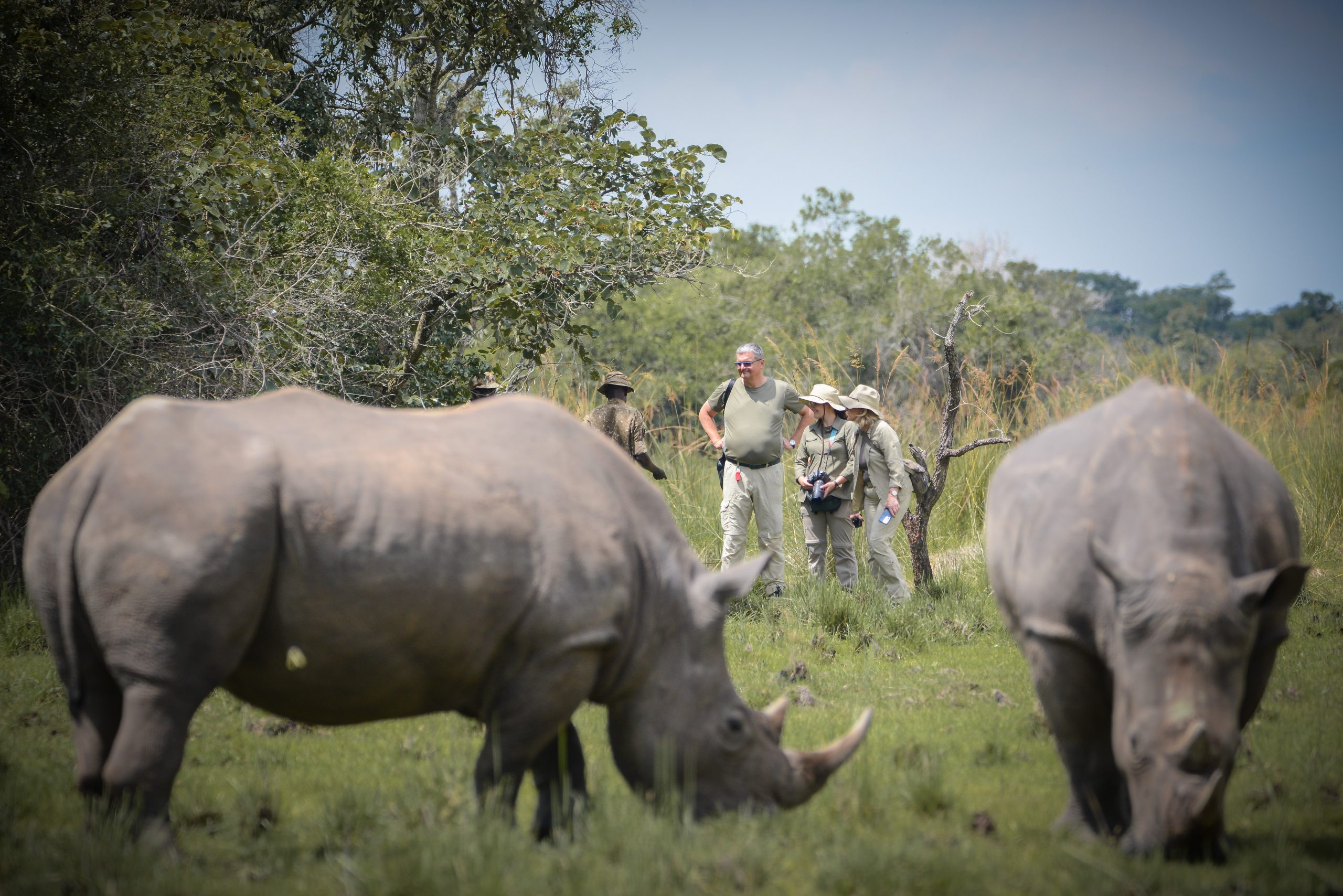
On the Trail of Giants: Rhino Tracking Adventures in Rwanda’s Akagera National Park
Rhino Tracking in Akagera National Park: Rhinos are one of the big five animals found in many African countries, but what makes them special in Rwanda? The Southern white Rhinos within Rwanda’s Akagera National Park are not only watched via Game drives but also tracked on-foot. This extraordinary wildlife experience was recently introduced in Akagera National Park, a home to the Big 5 game in 2022.
Send Enquiry For This Experience
Rhino History: Rhino Tracking in Akagera National Park

White Rhino in Akagera National Park.
Before translocation, wild Rhino populations thrived in Akagera National Park in the late 1970s. Then, about 50 of them called this savannah-dominated Park home. However due to conflicts, their natural habitats were encroached.
Conflicts included the such as the 1994 Genocide, population increase, they were also killed for bush meat.
A huge part of the Park was cleared for refugee settlement. Following that, its natural forests became a source of firewood, timber and livestock grazing area. The last Rhino was sighted in 2007.
It is for this reason that the Akagera Management Company was founded in 2010. This comprised of African Parks (a not-for-profit Organization that manages many National Parks in the African Continent) and Rwanda Development Board (RDB). This was followed by many conservation efforts. This also meant re-introduction of animals that once roamed in Akagera National Park and these included lions and Rhinos. The Eastern Black Rhinos were the first to be re-introduced in 2017. 18 of them were translocated from South Africa into Akagera National Park.
More 5 Rhinos (that included 2 males and 3 females) were translocated from different parts of Europe into Akagera National Park.
How Rhino Tracking is done in Akagera National Park?

Tourists observing Rhinos in Akagera NP.
On the day of tracking, travelers join the team of experienced trackers for briefing at the Park Headquarters. Herein they are told the various guidelines to be followed while on the trek. Afterwards, visitors are grouped in fours.
They then follow trails as they engage in monitoring exercise of these large mammal species. More like game drives, Rhino tracking too is exciting. Guests get the in depth behaviors of rhinos, their health and take as many photos as you wish.
Tracking the Rhinos gives a complete exposure to the big five game in Akagera National Park. It is conducted within the sweeping Kilala Plains. They lie North of the park. It should also be noted that it is at Kilala Plains where some of the translocated Southern White rhinos live.
Unlike the black rhinos that are more aggressive, territorial and browsers, the white rhinos are more placid, calmer and generally grazers. It is for this reason that the black rhinos roam within the Southern part of Akagera National Park marked by acacia vegetation.
Send Enquiry For This Experience
How much is a Rhino tracking permit in Akagera National Park?
Rhino tracking permits for Akagera National Park cost only $75 per person per tracking adventure. This doesn’t include Park entry fees. Given the fact that most visitors to Akagera are now interested Rhino tracking. Permits get scarse and that’s why it is advisable to buy permits in advance to avoid being left out.

African Grey Hornbill in Akagera National Park.
Besides Rhino tracking, Akagera National Park is known for other unmissable and exciting activities that include game drives, boat rides on Lake Ihema, Birding, guided bush walks, hot air balloon tours, and behind-the-scene experiences.
Other animals that roam through Akagera National Park landscape are Masai giraffes, lions, warthogs, Topis, roan antelopes, Burchell’s zebras, gazelles, spotted hyenas, Giant elands, Cape buffaloes, Defassa waterbucks, Kobs, impalas, blue monkeys, vervet monkeys, leopards, olive baboons, Duikers, Dik-diks, Oribis.
Akagera National Park is also a birding Paradise and one of the top Birding Apes in the country with about 500 species that include African skimmers, shoebill stork, grey-crowned canes, sacred ibis, Pied and giant Kingfishers, Papyrus gonolek, African fish eagle, cattle egrets, great white and pink-backed pelicans, White-browned coucal, Yellow-billed duck, African pygmy Goose, African darters, pied crow, squacco herons, African jacana, to mention but a few.
Where to stay during your Rhino tracking adventure in Akagera National Park?
The top places to stay in or around Akagera National Park are Ruzizi Tented Camp, Magashi Tented Camp, Karenge Bush Camp Akagera Game Lodge, and many others.
How to get to Akagera National Park for the Rhino tracking adventure?
Situated in the Eastern side of Rwanda, Akagera National Park is only about 105 kilometers from Kigali City, and that’s about two and a half hour’s drive. However, the Park is also accessible by helicopter flight that takes about 25-30 minutes only.



